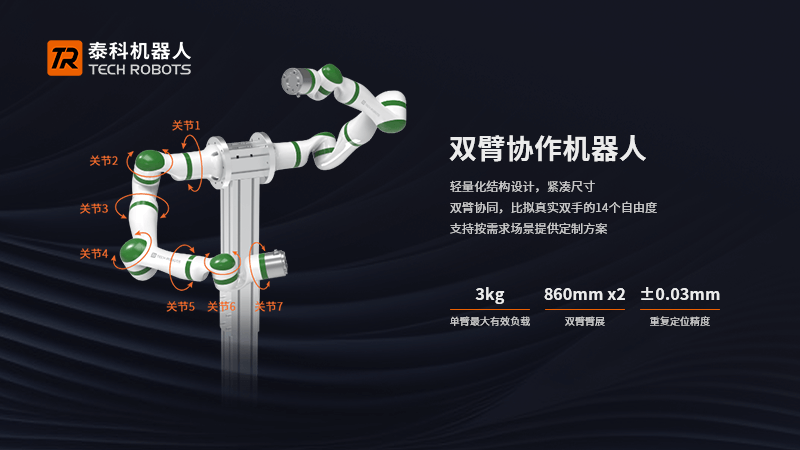The Emergence and Application of the New Era in Smart Healthcare: The Rise of the Dual-Arm 14-Axis Collaborative Robot
Date:2023-11-22With the rapid advancement of technology, the application of robotics in the field of healthcare is becoming increasingly widespread, especially with the emergence of dual-arm 14-axis collaborative robots. These robots, known for their flexibility and high-precision operation, are bringing unprecedented changes to the healthcare sector. This article delves into the potential, challenges, and future development directions of dual-arm 14-axis collaborative robots in medical applications, providing a comprehensive insight into how this leading technology is improving medical services and patient care.
A dual-arm 14-axis collaborative robot refers to a robot with two independent operating arms, each containing 7 degrees of freedom axes, totaling 14 movement axes. This structural design provides the robot with flexible operational capabilities similar to human limbs, enabling it to perform complex and intricate tasks. In the medical field, such robots can efficiently assist doctors in surgical procedures, provide emergency services, and carry out daily patient care.
Value of Collaborative Robots in the Medical Field:
Enhanced Surgical Collaboration: In complex surgeries, dual-arm robots can collaborate with doctors, with one arm assisting in organ fixation and the other performing operations, effectively reducing the workload on doctors and shortening surgery duration.
Improved Efficiency and Cost Reduction: Robots can work continuously without interruption, reducing the need for human resources compared to specialized medical staff. This not only lowers costs but also reduces medical errors caused by human factors, thus saving hospitals expenses.
Technical Features of Dual-Arm 14-Axis Collaborative Robots:
High Flexibility and Adaptability: These robots can simulate human hand operations, performing precise actions such as grasping, moving, and rotating. Their adaptability allows them to handle various complex situations.
Advanced Sensory Abilities: Equipped with high-precision sensors, robots can real-time sense the surrounding environment and the state of the operating objects, enabling precise control even in obstructed visibility conditions.
Powerful Learning and Adaptive Functions: Utilizing artificial intelligence and machine learning, these robots can continuously learn and optimize their action patterns to adapt to the evolving medical environment and demands.
Application Case Analysis:
Rehabilitation Medicine: Dual-arm robots can assist patients in daily rehabilitation training in rehabilitation centers, such as supporting walking and exercise therapy, providing stable and precise rehabilitation experiences.
Medication Delivery and Care: In hospitals, 14-axis robots can assist medical staff in delivering medications, handling medical waste, and even providing patient care services. By accurately executing daily tasks, they allow medical personnel to focus more on clinical diagnosis and patient care.
Challenges and Future Prospects:
Despite the vast potential of dual-arm 14-axis collaborative robots, challenges like high initial costs, technological acceptance, and the need for standardization within legal frameworks remain. Future development will focus on cost reduction, increased intelligence, and the establishment of relevant standards.
The emergence of dual-arm 14-axis collaborative robots signifies a crucial step in medical automation and intelligence. It not only improves the quality and efficiency of surgeries but also enhances the patient care experience. As technology matures and applications deepen, we have reason to believe that these robots will play an increasingly important role in the global medical field.
